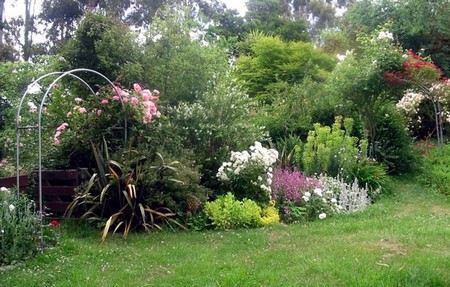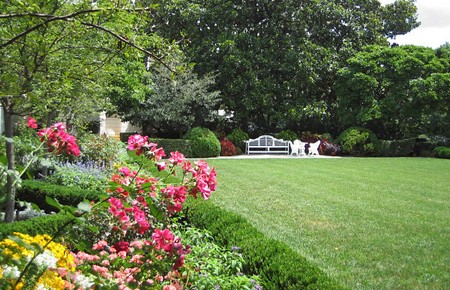If you want lots of summer colour, perhaps around a patio or in front of a porch, then of course any of the summer bedding plants can be used. These can be followed with spring bedding and bulbs. But if you want planting schemes which are a bit out of the ordinary (and indeed labour-saving) then there is a wide range of attractive permanent plants that you could choose from.
Rock plants immediately spring to mind. I have already recommended some for raised beds, but some of the more popular, showy kinds could be used if you want lots of colour, like the ever-popular yellow Alyssum saxatile, blue, purple, red or pink aubrieta, and white arabis. I know that this particular scheme is very much over-done, but if you want plenty of colour in spring it takes a lot of beating.

Other rock plants you could use include trailing campanulas with blue flowers, like C. portenschlagiana, which can be planted in the sides of a dry-stone wall; the rock pinks or dianthus; rock roses or helianthemums whose single-rose-like flowers come in a wide range of bright colours; the white perennial candytuft or Iberis sempervirens; lewisias, which are ideal for planting in the sides of a dry-stone wall, as are the sempervivums or houseleeks; and the creeping thymes, or varieties of Thymus serpyllum.
Dwarf bulbs could be planted with the rock plants, such as tulip, crocus and dwarf allium species. These, and the alpines, need plenty of sun.
There are lots of dwarf shrubs which enjoy a sunny spot, including the brooms. Try Cytisus X beanii with yellow flowers, and C. X kewensis, with sheets of cream blooms, both at their best in late spring. Then there is Genista lydia with masses of golden flowers at that time of year. Daphne arbuscula is a small evergreen shrub which bears scented pink flowers in early summer. Try some dwarf berberis, too, like the B. thunber-gii varieties ‘Atropurpurea Nana’, purple foliage’ and ‘Kobold’ with shiny green leaves. B. buxifolia ‘Nana’ forms an evergreen mound and bears yellow flowers.
Small perennials which would enjoy the dryish conditions of the double wall, and which need full sun, include Anthemis cupaniana with attractive greyish foliage and a long succession of white daisy-like flowers in summer and through to autumn. The red valerian, Centranthus ruber, can be planted in the sides of a dry-stone wall. It flowers continuously from early to late summer, carrying panicles of deep pink or red flowers, set against glaucous foliage. There is also a white-flowered form, Albus’.
The stems of the spurge, Euphorbia myrsinites, will trail over the edge of the wall and are clothed with attractive bluish-grey foliage. In the spring acid-yellow flowers are produced. Oenothera missouriensis has a similar habit of growth, and throughout summer it bears large saucer-shaped yellow flowers.
The herbaceous potentillas relish sunny, dryish conditions and produce attractive single-rose-like flowers in spring or summer. A particularly attractive species is Potentilla tabernaemontani which forms an evergreen mat, studded in spring with yellow flowers.

The stonecrops or sedums will certainly be at home in a wall, and if it is dry-stone can be planted in the sides. Try species like S. acre, yellow flowers; S. album, white; S. cauticolum, red; S. spathulifolium and its varieties ‘Purpureum’ wich purple foliage and the grey-leaved ‘Cappa Blanca’; and S. spurium with deep pink flowers.
The Californian fuchsia, Zauschneria californica, is a somewhat unusual and desirable plant which bears red fuchsia-like flowers in summer and autumn, set against greyish-green foliage.